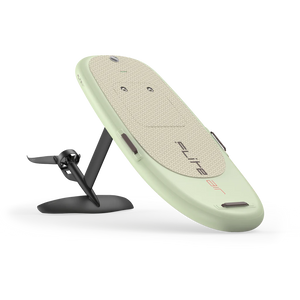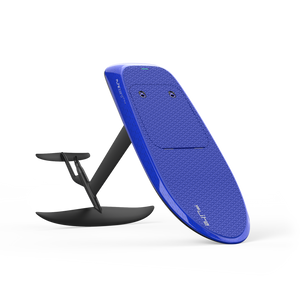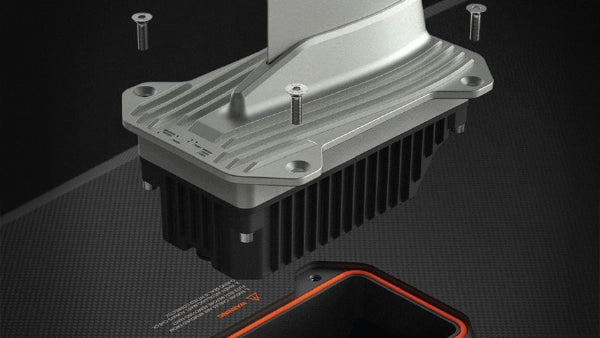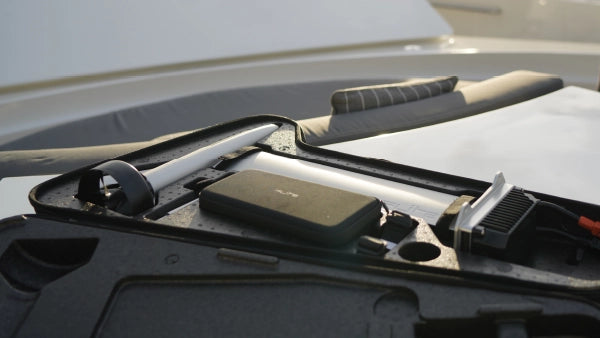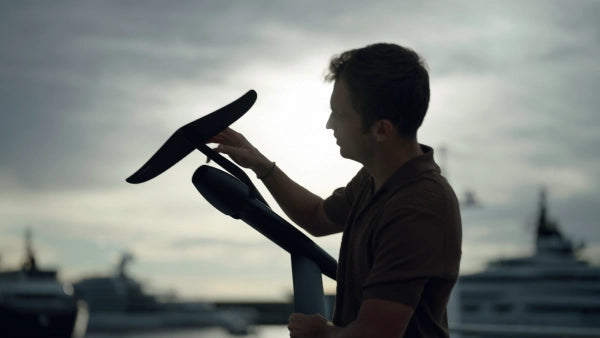Which eFoil wing is right for me?
Estimated reading time: 6 minutes
Fliteboard wings are designed specifically for electric hydrofoiling. Expert hydrodynamicists created our range of strong and interchangeable wings. There is always something new to discover by changing your wings. It’s one of the easiest ways to transform your ride.
With twelve wings and five stabilisers, there are many possibilities to choose from. We’ll walk you through an overview of each range below. You can learn more details about each wing here and if you’re still unsure, contact our global support team for advice.
Cruiser Wings
Stable, early takeoff, most popular
For beginners to advanced riders
Wings: Cruiser 1100, Cruiser 1800
Cruiser wings have been designed for maximum stability. Wing tips turn down for safety and stability, so beginners choosing Flite Propeller should start off with this range. If you’re a beginner and a heavier rider then the Cruiser 1800 will be best to start with. It’s the wing most used at Fliteschools around the world.
Cruiser Jet Wings
Stable, early takeoff, optimised for Flite Jet
For beginners to advanced riders
Wings: Cruiser Jet 1500, Cruiser Jet 1800
If you’re riding with Flite Jet then we recommend our Cruiser Jet range. These stable wings have been designed for maximum efficiency and early takeoff with Flite Jet. Their larger size and slight anhedral design also make them suitable for riders wanting to cruise at lower speeds but with more manoeuvrability than the standard Cruiser range. Wings in this series also have down turned tips for safety. Cruiser Jet wings are great for adventures thanks to their efficiency.
Cruiser Jet wings are also great if you're using the prop. Enjoy maximum efficiency, ride time, early takeoff, stability and manoeuvrability. Ride with the True Glide prop for exceptional glide on swell.

Flyer Wing
High speed, responsive turns
For intermediate to advanced riders
Wing: Flyer 800
For more stability at speed, the Flyer wing is a higher aspect option. It's 800 cm2 which allows you to ride faster. The high anhedral design reduces roll rate for a more stable ride. Use a lower number shim for riding faster (more on that later).
Removing the prop guard is the number one thing that's going to increase the board’s responsiveness. That's the next step after you progress to the Flyer wing. Only remove the prop guard if beginners won’t be using your board. You need to be confident in releasing the trigger and falling away from the board at this stage.
Flow Wings
Loose, most manoeuvrable, wave riding
For intermediate to advanced riders
Wings: Flow 1300, Flow 1100, Flow 900
It’s a big step change to Flow wings. If you've used a Flyer wing, you will know there's a big difference between the Flyer wing and the Cruiser wing. When you go to a Flow wing, that difference is three times greater. Flow wings really are that responsive.
We recommend starting off with a bigger Flow wing, like the 1300. If you are more confident or a lighter rider, then perhaps the Flow 1100. With higher aspect ratios than the Cruiser ranges and a dihedral design, they are more efficient and incredibly manoeuvrable. High aspect tips and a tailored lift distribution also result in incredible ventilation resistance during wingtip breaches.
If you’re riding flat water, choose a smaller Flow wing for faster riding. If you want to ride waves, use the Flow 1300 or Flow 1100 for bigger waves. These wings have been designed to lift and ride slowly but with maximum roll rate, so you can use the wave energy but still have a very responsive ride.

Flow S Wings
Loose, responsive, extreme roll rate
For intermediate to advanced riders
Wings: Flow S 1300, Flow S 1100, Flow S 900
Flow S wings are the lower aspect of the Flow range, for an even looser ride at the expense of glide. Their large tips are not as ideal as the Flow range for wing breaches and their aspect ratio is not as well suited to unpowered riding. Flow S wings are best for turning and carving. The most responsive wing is the Flow S 900. It’s like riding a skateboard with loose trucks.
Race Wing
High speed, responsive turns
For advanced riders
Wing: Race 700
If you’re familiar with the Flyer wing, you’ll feel the similarity on a Race wing. However, it’s a scaled-down, higher-performance version. It's got less of the anhedral shape, so you have to be careful with the pointier tips. It's higher aspect and will take you over 50 km/h if you want to push speed in a straight line. It needs more force to make it turn than the Flow wings, but that gives you good feedback. It's like snowboarding with hard boots. This is a great wing to put on your PRO board.
Wings on ULTRA / L
The most extreme eFoil ride
For advanced riders
If you're buying an ULTRA / L, you're a competent rider. You can already Fliteboard, and you've already ridden a PRO. You've probably taken the propeller guard off and used the Flyer wing.
ULTRA's not an easy board to get up on. It takes a different technique. You've got to get the board planing by trimming the board and keeping it very flat. Every bit of angle takes away forward thrust from the propeller.
A large Flow or Flow S wing, Cruiser or Cruiser Jet wing, or a Flyer wing, will be the easiest options for getting acquainted with ULTRA / L. From there, you can start using a smaller Flow wing or the Race wing for more speed.
If you're riding waves, then choose a bigger wing such as Flow or Flow S 1100 or 1300, or Cruiser Jet 1500, so that you can turn the motor off and glide. Heavier riders should try Flow 1300 or 1100. Lighter riders are better suited to Flow 900, Flyer and Race wings.
Stabilisers and Shims
Fine tune your performance
Finally, we get to stabilisers and shims. The stabiliser is the smaller wing to the rear of the propulsion system. Every stabiliser has been designed to pair with specific wings. This fine tunes your riding experience. Choose from Flite 290, Flite 500, Cruiser Jet 300, Flow 245 and Race 200.
Fliteboard is the only eFoil range in the world that allows the rear stabiliser to be adjusted. Changing the angle of the stabiliser makes a big change in terms of the way the board feels. This can be accomplished through the use of shims. Every board comes with six shims. They start off at zero degrees, and go through to five degrees.
With a higher number, you get more front foot pressure and more turning response on the wing. As you go lower, you get less front foot pressure (particularly as you go faster) because the stabiliser has a lower angle of attack and creates less stabilisation / down force. As you create more forward momentum, that angle creates a lot of down force that you've got to compensate with your body weight by standing further forward on the board and putting more force through your front leg.
Zero to Three
The most popular choices
Over time we've learned that most people want to be working with shims in the 0 - 3 range. If you're an advanced rider who wants to ride fast, and you don't want to have that front foot pressure, use a 0 shim or a 1 shim. If you’re a beginner or want to ride a little bit slower, use a 1 or 2 shim. A 1 or 2 shim will also be suitable for those who want pitch stability and more response.
Configure your Setup
The fun part
We hope this has been a helpful overview of our eFoil wings, stabilisers and shims. If you’re buying a complete setup, our user friendly Configure page will guide you with ease. If you already have a Fliteboard and want to add a new wing set, visit our Shop. Still have questions? Our Global Customer Support is available 24/7.


